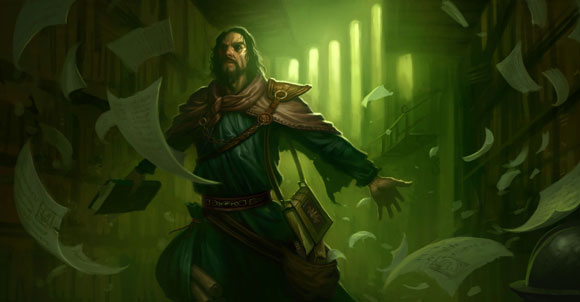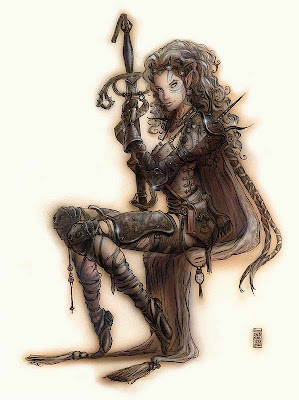Animal/Vermin
For animals, wolves tap into the complex relationship humans have with canines. Wolves are a common and significant threat at low levels in many settings/games. They're smart and come in packs, a dangerous foe indeed. The mid-game derivatives (dire wolves, worgs, winterwolves, etc) scales them up for some staying power, even if some of those start to lose their simple animal type. At the same time, they're also the basis for the faithful hounds people can have as pets, or druids and rangers can often pick a wolf as a companion. Stronger alternatives exist, but wolves remain a cool option.
Have to pick rats for vermin. Nuisances unworthy of true adventures you might say, but the most recognizable of rodents advances through bestiaries with advanced forms. The low-level fodder trope has so much purchase it can be subverted for kicks to screw with players, such as the cranium rats in Planescape Torment.
Heck, the rat is so popular several games and settings have ratling/nezumi/ratfolk/skaven races. My anecdotal observation, but the most requested anthropomorphic animal race seems to be cat-people. Yet despite cats and cat-lovers owning the internet, rat-people are more commonly implemented in games. Must be all the Mickey/Mighty/Speedy/Jerry cartoons working their subliminal magic, as well as Redwall and the most excellent Mouse Guard.
Honorable mention: Bugs/Insects in general can always be used to good effect, based on their innate alien-like, exoskeletal forms (like the Mythosic invertebrate creepiness, but on land), and proclivity to swarm or have their size magnified in enormity (worst case scenarios for each extreme) for monstrous uses.
Immortal/Outsider
Let's split this into fiendish and ... less-fiendish outsiders.
For fiend, it's Pit Fiends. They're more low-key than the fiery whip and vorpal sword wielding Balors. Even their name seems a nondescript mundane moniker for a rank-and-file foot soldier of hell. Don't let that fool you, they're top of the non-unique food chain in the diabolical hierarchy.
Within their rank we have some variance. Few exemplify the diabolical twist on lawful duty like the Evil Eight who conduct the Blood War to the exclusion of all else. They've even become fixed identities with newer pit fiends claiming the names of those who have fallen throughout the eons, all for the causes. Even then, despite their position they're are capable schemers, such as Bel who masterminded his superior's fall in order to claim Avernus and the title Lord of the First for himself.
Less-fiendish outsider would be Asura, whether the free-spirited, bringers of divine wrath of the 3E era or Pathfinder's take based more on Vedic mythology. I love the concept being so established in the real world, but possible to interpret so differently that these versions can exist in-game and not conflict. While mirroring the real world at times, Asuras are nebulous enough to implement in-game on either side of the alignment spectrum. Asuras are the true planar mongrels of both myth and gaming.
Elemental/Plant
Can't get more iconic than the fire elemental. The other main elementals are no less powerful or interesting, but they tend to blend into the natural world. Nothing says elemental more than a burning figure walking about setting things on fire, but not screaming with the agony of actually being on fire.
Haven't thought about plant monsters much, they're useful to be sure. Maybe treant, a walking talking tree, not only well established, but undeniably represents plant. Vine and meat-eater plants if we want to up the discomfort level, but getting smacked around by a mobile tree can be horrifying as well.
Humanoid/Natural/Fey
Hobgoblins seem an interesting change of pace from the howling hordes of standard humanoid monsters. Even if their implementation often still lags behind the enhanced fluff of organized and relatively disciplined goblinoids. If there is any threat greater than a chaotic expendable horde with nothing to lose, it's a regimented and capable army with something to gain.
With fey, my pick is not quite of the subtype (I think they're primarily outsiders), but I think one of the most interesting monsters to come out of the Epic Level Handbook were the LeShay. Mechanically they're nothing too remarkable and they have a funny name, but they're interesting based solely on their background. The LeShay are ur-fey from another multiverse before this one. They precipitated a fuck-up so grand they altered existence itself, erasing their own universe and started a new one (ours, well 'ours' to our PCs anyway). Being immortal, the LeShay bore witness to time trickle by in the current multiverse. Some probably attempted to reverse their fortune with catastrophic results no doubt, others whittle away the eons in ennui. They can serve as epic universe-shattering masterminds, cruel decadent villains from beyond time immemorial, or mysterious manipulators behind the scenes, benefactors or not. Any interaction with them can give characters a glimpse of the grandness of the multiverse. The LeShay concept dared to think big and pulled it off, which I feel is more than can be said of most monsters from the Epic Level Handbook.
Dragon Color/Type
Definitely blues. They're an unexpected color and environmental match up. The reds being portrayed as big and fiery is classically befitting of the kings of the chromatic dragons. Likewise, the whites are their literal polar opposites. Blacks paired with swamps and acid also presents a logical grim and gloomy evil dragon motif. Green dragons harken back to the reptilian look and paired with the equally viridian forests.
While electricity is often paired with blue, it could just as easily be linked with yellow or white (the white and blue dragons could easily have their colors interchanged without much disruption to their respective themes). Blue is a striking hue not often found amongst animals (or dragons for that matter, outside of games). Blues are also desert dwelling in some instances of game lore. That takes the game away from the well-tread temperate climate Euro-milieu of the default implied setting. That they're often portrayed as the second most powerful chromatic species also makes them capable menaces. Unless a dragon breathing lightning bolts isn't hint enough of their threat and danger.
 |
| The blues for 3E with the big horn and gnarly jaw were certainly distinctive, but Ben Wooten's sleek take on blues for Pathfinder is pure class. |
Favorite Overall Monster
Humans!
Who else. For the most part humans are the dark lords, the iron-fisted tyrants, corrupt nobles and vile cultists, deadly assassins and two-bit thugs, or the ever popular mad archmages (with or without lichdom) who threaten the people and places the adventurers love (if not promising harm directly against them). From masterminds to champions to henchmen, the bulk of the villains in games are people just like us.
Least Favorite Overall Monster
None. Simple as that.
Paizo's Misfit Monsters Redeemed has shown even the silliest monsters of D&D-type games can be refreshed into interesting additions to the game. Not that people need any help from a company given the strange following for gonzo monsters like Flumph and Flail Snails.
There is only one constant in regards to monsters, more is better.

































